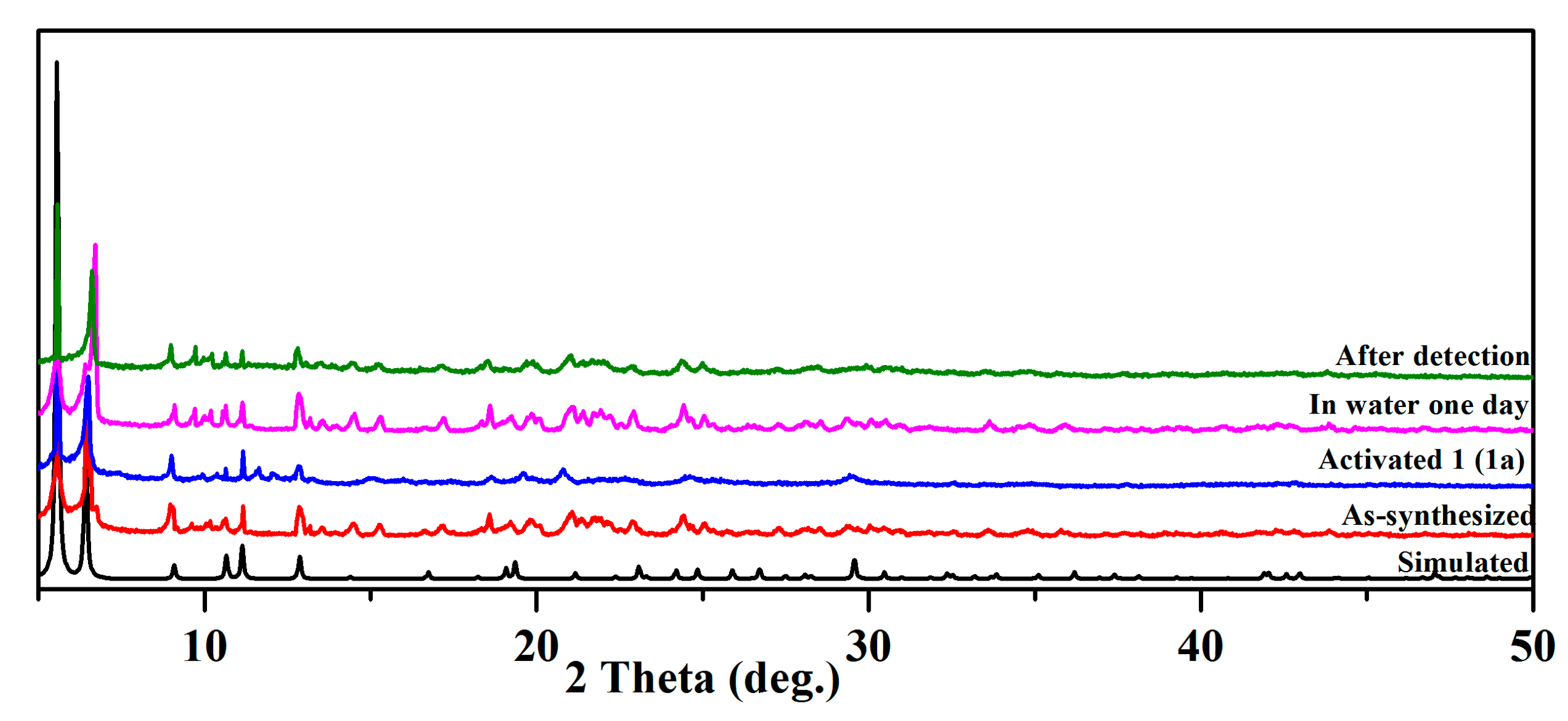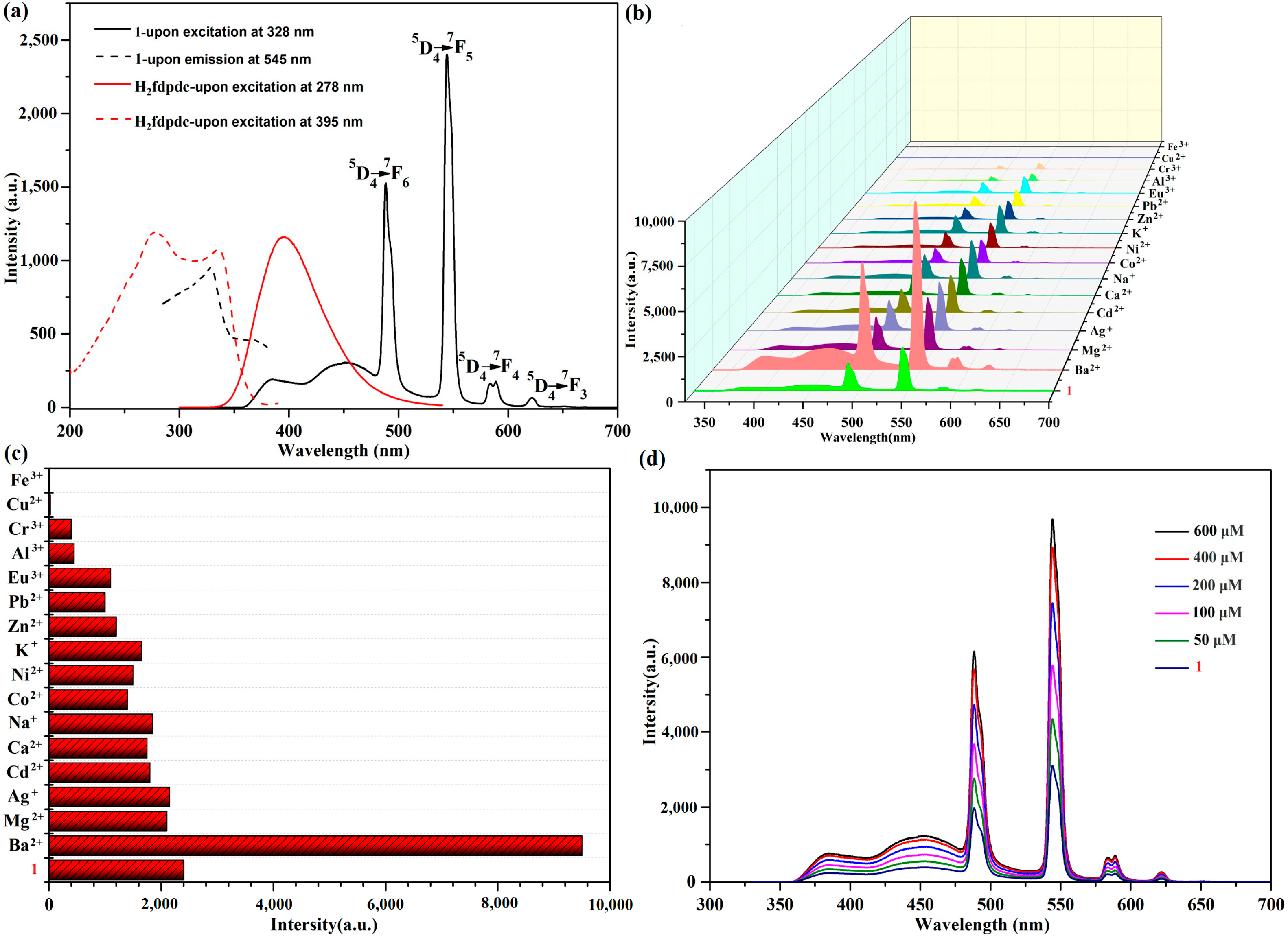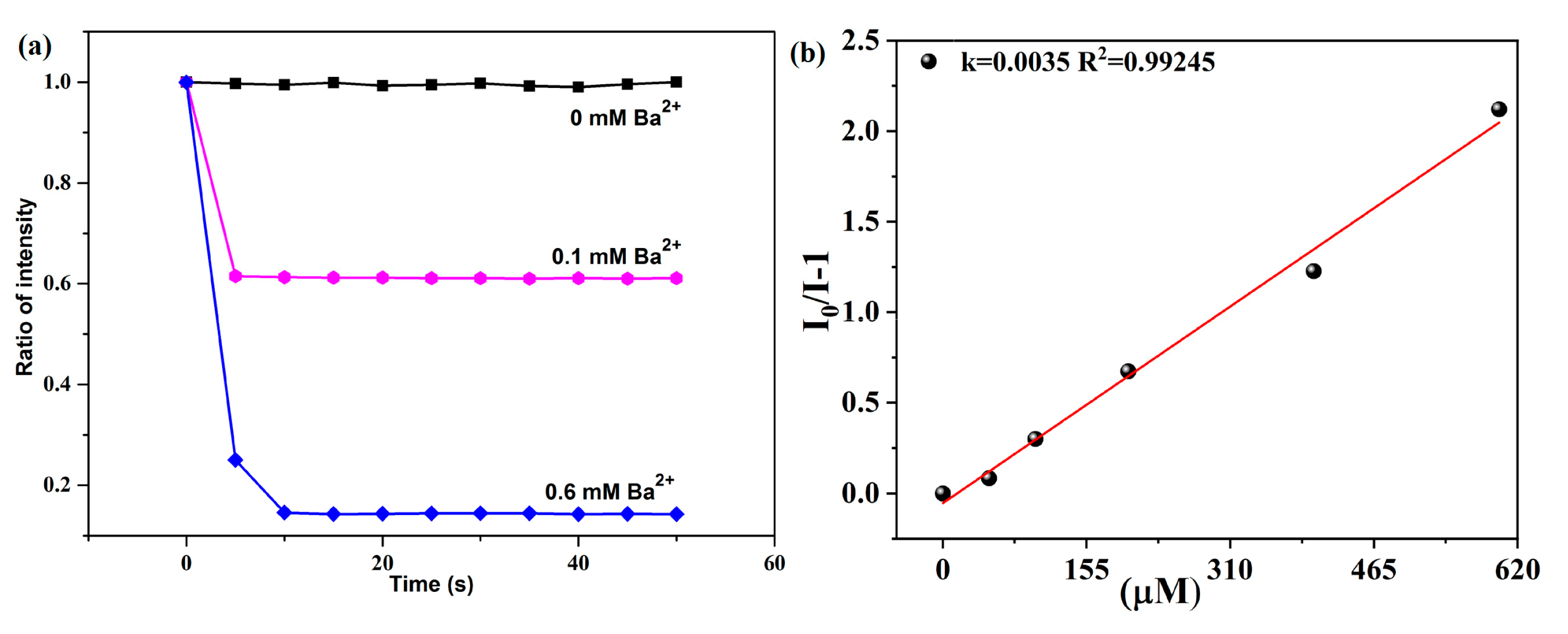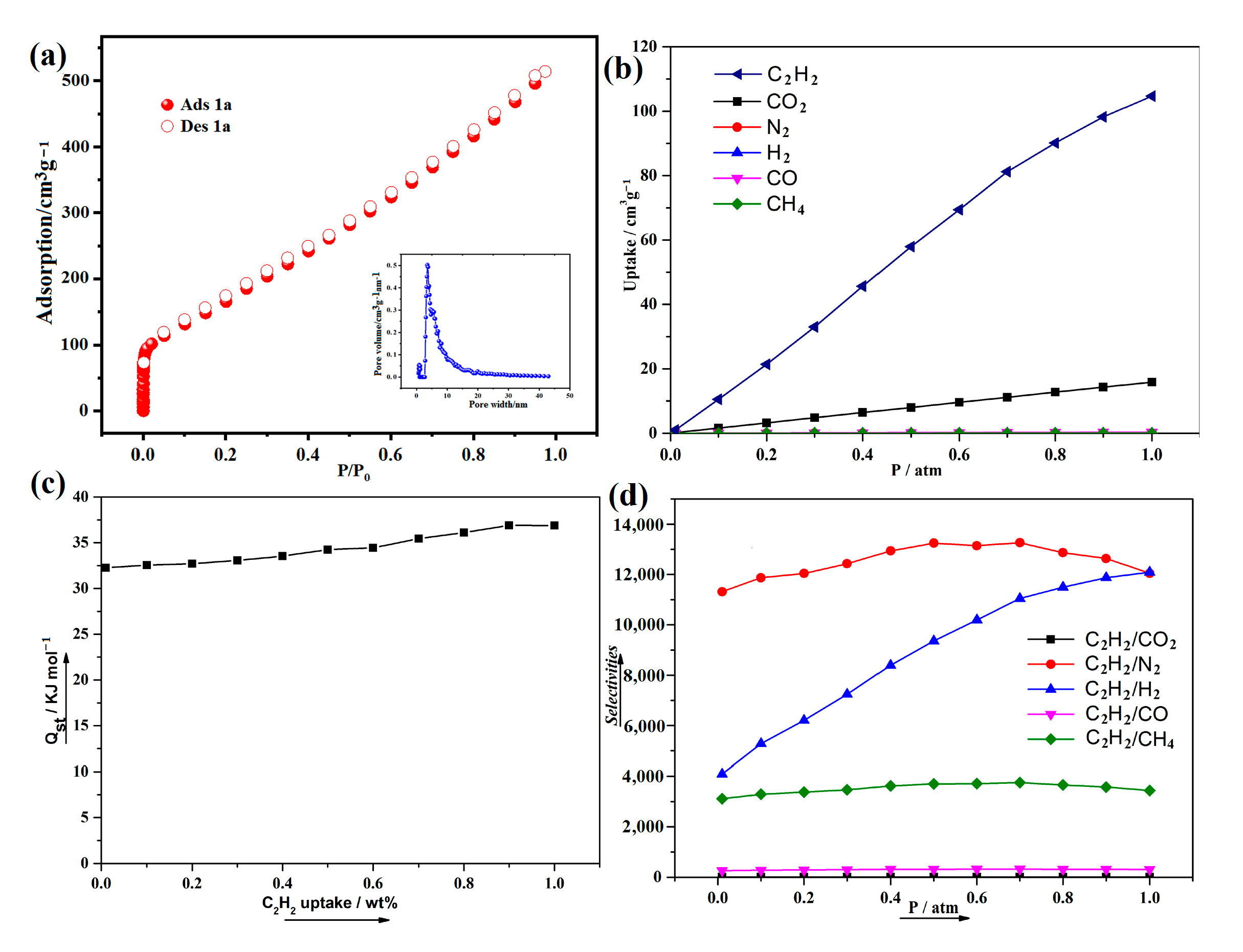A Fluorine-Functionalized Tb(III)–Organic Framework for Ba2+ Detection
Abstract
1. Introduction
2. Results and Discussion
2.1. The Crystal Structure of Complex 1
2.2. IR, TGA, and PXRD Analyses
2.3. Sensing of 1 Toward Ba2+ Ion
2.4. Sorption Performances
3. Materials and Methods
3.1. Materials and Physical Measurements
3.2. Synthesis of {[Tb6(fdpdc)6(μ3-OH)8(H2O)6]·4DMF}n (1)
3.3. X-Ray Crystal Structural Determination
3.4. Preparation of Ba2+ Aqueous Solution
3.5. Fluorescent Studies
3.6. Theoretical Simulations Section
4. Conclusions
Supplementary Materials
Author Contributions
Funding
Institutional Review Board Statement
Informed Consent Statement
Data Availability Statement
Acknowledgments
Conflicts of Interest
References
- Yu, H.H.; Chi, J.Q.; Su, Z.M.; Li, X.; Sun, J.; Zhou, C.; Hu, X.L.; Liu, Q. A water-stable terbium metal-organic framework with functionalized ligands for the detection of Fe3+ and Cr2O72− ions in water and picric acid in seawater. CrystEngComm 2020, 22, 3638–3643. [Google Scholar] [CrossRef]
- Yang, Y.; Jiang, F.; Chen, L.; Pang, J.; Wu, M.; Wan, X.; Pan, J.; Qian, J.; Hong, M. An unusual bifunctional Tb-MOF for highly sensitive sensing of Ba2+ ions and with remarkable selectivities for CO2-N2 and CO2-CH4. J. Mater. Chem. A 2015, 3, 13526–13532. [Google Scholar] [CrossRef]
- Ma, D.; Chen, C.; Chen, M.; Zhu, S.; Wu, Y.; Li, Z.; Li, Y.; Zhou, L. A hydrostable Cadmium-Organic Framework for Highly Selective and Sensitive Luminescence Sensing of Al3+ Ion. J. Inorg. Organomet. Poly. Mater. 2019, 29, 1829–1837. [Google Scholar] [CrossRef]
- Carter, K.; Young, A.; Palmer, A. Fluorescent sensors for measuring metal ions in living systems. Chem. Rev. 2014, 114, 4564–4601. [Google Scholar] [CrossRef] [PubMed]
- D’Alessandro, D.M.; Smit, B.; Long, J.R. Carbon dioxide capture: Prospects for new materials. Angew. Chem. Int. Ed. 2010, 49, 6058–6082. [Google Scholar] [CrossRef]
- Sahoo, S.; Mondal, S.; Sarma, D. Luminescent Lanthanide Metal Organic Frameworks (LnMOFs): A Versatile Platform towards Organomolecule Sensing. Coord. Chem. Rev. 2022, 470, 214707. [Google Scholar] [CrossRef]
- Pal, S.C.; Ahmed, R.; Manna, A.K.; Das, M.C. Potential of a pH-Stable Microporous MOF for C2H2/C2H4 and C2H2/CO2 Gas Separations under Ambient Conditions. Inorg. Chem. 2022, 61, 18293–18302. [Google Scholar] [CrossRef]
- Zhang, X.Y.; Shi, W.J.; Wang, G.D.; Hou, L.; Wang, Y.Y. One Co-MOF with F Active Sites for Separation of C2H2 from CO2, C2H4, and CH4. Inorg. Chem. 2023, 62, 16574–16581. [Google Scholar] [CrossRef]
- Wang, G.D.; Li, Y.Z.; Zhang, W.F.; Hou, L.; Wang, Y.Y.; Zhu, Z. Acetylene Separation by a Ca-MOF Containing Accessible Sites of Open Metal Centers and Organic Groups. ACS Appl. Mater. Interfaces 2021, 13, 58862–58870. [Google Scholar] [CrossRef]
- Zhang, R.; Zhu, L.; Yue, B. Luminescent properties and recent progress in applications of lanthanide metal-organic frameworks. Chin. Chem. Lett. 2023, 34, 108009. [Google Scholar] [CrossRef]
- Zhang, W.; Zhang, J.; Dong, X.; Li, M.; He, Q.; Zhao, S.; Xie, L. Fluorinated metal–organic frameworks for enhanced stability and iodine adsorption selectivity under humid conditions. Chem. Eng. J. 2023, 461, 142058. [Google Scholar] [CrossRef]
- Xie, J.; Sun, F.; Wang, C.; Pan, Q. Stability and hydrocarbon/fluorocarbon sorption of a metal-organic framework with fluorinated channels. Materials 2016, 9, 327. [Google Scholar] [CrossRef] [PubMed]
- Noro, S.; Nakamura, T. Fluorine-functionalized metal-organic frameworks and porous coordination polymers. NPG Asia Mater. 2017, 9, e433. [Google Scholar] [CrossRef]
- Santra, A.; Lah, M.S.; Bharadwaj, P.K. A partially fluorinated three-fold interpenetrated stable metal-organic framework with selective CO2 uptake. Z. Anorg. Allg. Chem. 2014, 640, 1134–1140. [Google Scholar] [CrossRef]
- Xue, D.X.; Cairns, A.J.; Belmabkhout, Y.; Wojtas, L.; Liu, Y.; Alkordi, M.H.; Eddaoudi, M. Tunable Rare-Earth fcu-MOFs: A Platform for Systematic Enhancement of CO2 Adsorption Energetics and Uptake. J. Am. Chem. Soc. 2013, 135, 7660–7667. [Google Scholar] [CrossRef]
- Huheey, J.; Keiter, E.A.; Keiter, R.L. Inorganic Chemistry: Principles of Structure and Reactivity, 4th ed.; Pearson Education: New York, NY, USA, 2000. [Google Scholar]
- Blatov, V.A.; Shevchenko, A.P.; Proserpio, D.M. Applied Topological Analysis of Crystal Structures with the Program Package ToposPro. Cryst. Growth Des. 2014, 14, 3576–3586. [Google Scholar] [CrossRef]
- Ma, K.; Li, J.; Ma, H.; Yang, Y.; Yang, H.; Lu, J.; Li, Y.; Dou, J.; Wang, S.; Liu, S. 2D Cd-MOF and its mixed-matrix membranes for luminescence sensing antibiotics in various aqueous systems and visible fingerprint identifying. Chin. Chem. Lett. 2023, 34, 108227. [Google Scholar] [CrossRef]
- Yang, G.L.; Jiang, X.L.; Xu, H.; Zhao, B. Applications of MOFs as Luminescent Sensors for Environmental Pollutants. Small 2021, 17, 2005327. [Google Scholar] [CrossRef]
- Chen, D.M.; Qiao, H.D.; Fang, S.M. Introduction of functionality into a Tb(III)-organic framework via mixed-ligand strategy for selective C2H2 capture and ratiometric Cr(VI) detection. J. Rare Earths, 2024; in press. [Google Scholar] [CrossRef]
- Xu, Q.; Guo, Z.; Zhang, M.; Hu, Z.; Qian, Y.; Zhao, D. Highly efficient photocatalysts by pyrolyzing a Zn-Ti heterometallic metal-organic framework. CrystEngComm 2016, 18, 4046–4052. [Google Scholar] [CrossRef]
- Singha, D.K.; Mahata, P. Highly Selective and Sensitive Luminescence Turn-On-Based Sensing of Al3+ Ions in Aqueous Medium Using a MOF with Free Functional Sites. Inorg. Chem. 2015, 54, 6373–6379. [Google Scholar] [CrossRef]
- Zhang, M.; Qi, Z.; Feng, Y.; Guo, B.; Hao, Y.; Xu, Z.; Zhang, L.; Sun, D. A 2D porous pentiptycene-based MOF for efficient detection of Ba2+ and selective adsorption of dyes from water. Inorg. Chem. Front. 2018, 5, 1314–1320. [Google Scholar] [CrossRef]
- Chen, D.M.; Zheng, Y.P.; Fang, S.M. Microporous mixed-ligand metal-organic framework with fluorine-decorated pores for efficient C2H2/C2H4 separation. J. Solid State Chem. 2021, 296, 121990. [Google Scholar] [CrossRef]
- Alduhaish, O.; Lin, R.-B.; Wang, H.; Li, B.; Arman, H.D.; Hu, T.-L.; Chen, B. Metal-Organic Framework with Trifluoromethyl Groups for Selective C2H2 and CO2 Adsorption. Cryst. Growth Des. 2018, 18, 4522–4527. [Google Scholar] [CrossRef]
- Zheng, J.; Cui, X.; Yang, Q.; Ren, Q.; Yang, Y.; Xing, H. Shaping of ultrahigh-loading MOF pellet with a strongly anti-tearing binder for gas separation and storage. Chem. Eng. J. 2018, 354, 1075–1082. [Google Scholar] [CrossRef]
- Li, L.; Lin, R.-B.; Krishna, R.; Wang, X.; Li, B.; Wu, H.; Li, J.; Zhou, W.; Chen, B. Efficient separation of ethylene from acetylene/ethylene mixtures by a flexible-robust metal-organic framework. J. Mater. Chem. A 2017, 5, 18984–18988. [Google Scholar] [CrossRef]
- Fan, W.; Wang, X.; Liu, X.; Xu, B.; Zhang, X.; Wang, W.; Wang, X.; Wang, Y.; Dai, F.; Yuan, D.; et al. Regulating C2H2 and CO2 Storage and Separation through Pore Environment Modification in a Microporous Ni-MOF. ACS Sustain. Chem. Eng. 2019, 7, 2134–2140. [Google Scholar] [CrossRef]
- Fan, W.; Wang, X.; Zhang, X.; Liu, X.; Wang, Y.; Kang, Z.; Dai, F.; Xu, B.; Wang, R.; Sun, D. Fine-tuning the pore environment of the microporous Cu-MOF for high propylene storage and efficient separation of light hydrocarbons. ACS Cent. Sci. 2019, 5, 1261–1268. [Google Scholar] [CrossRef]
- Cheplakova, A.M.; Kovalenko, K.A.; Vinogradov, A.S.; Karpov, V.M.; Platonov, V.E.; Fedin, V.P. A comparative study of perfluorinated and non-fluorinated UiO-67 in gas adsorption. J. Porous Mater. 2020, 27, 1773–1782. [Google Scholar] [CrossRef]
- Fan, W.; Yuan, S.; Wang, W.; Feng, L.; Liu, X.; Zhang, X.; Wang, X.; Kang, Z.; Dai, F.; Yuan, D.; et al. Optimizing Multivariate Metal-Organic Frameworks for Efficient C2H2/CO2 Separation. J. Am. Chem. Soc. 2020, 142, 8728–8737. [Google Scholar] [CrossRef]
- Li, Y.-Z.; Wang, H.-H.; Wang, G.-D.; Hou, L.; Wang, Y.Y.; Zhu, Z. A Dy 6-cluster-based fcu-MOF with efficient separation of C2H2/C2H4 and selective adsorption of benzene. Inorg. Chem. Front. 2021, 8, 376–382. [Google Scholar] [CrossRef]
- Cui, X.; Chen, K.; Xing, H.; Yang, Q.; Krishna, R.; Bao, Z.; Wu, H.; Zhou, W.; Dong, X.; Han, Y.; et al. Pore chemistry and size control in hybrid porous materials for acetylene capture from ethylene. Science 2016, 353, 141–144. [Google Scholar] [CrossRef] [PubMed]
- Ma, D.; Li, Z.; Jiang, F.; Ma, Y.; Lin, W.; Wen, M.; Liu, B.; Xu, J. Selective CO2 Adsorption By Methyl-Functionalized Metal-Organic Framework. ChemistrySelect 2017, 2, 7821–7826. [Google Scholar] [CrossRef]
- Bruker. APEXII Software; Version 6.3.1; Bruker AXS Inc.: Madison, WI, USA, 2004. [Google Scholar]
- Sheldrick, G.M. A short history of SHELX. Acta Cryst. 2008, A64, 112–122. [Google Scholar] [CrossRef]
- Spek, A.L. PLATON, A Multipurpose Crystallographic Tool; Utrecht University: Utrecht, The Netherlands, 2005. [Google Scholar]
- Potoff, J.J.; Siepmann, J.I. Vapor-liquid equilibria of mixtures containing alkanes, carbon dioxide and nitrogen. AIChE 2001, 47, 1676–1682. [Google Scholar] [CrossRef]
- Martin, M.G.; Siepmann, J.I. Transferable Potentials for Phase Equilibria. 1. United-Atom Description of n-Alkanes. J. Phys. B 1998, 102, 2569–2577. [Google Scholar] [CrossRef]
- Chen, B.; Liang, C.; Yang, J.; Contreras, D.S.; Clancy, Y.L.; Lobkovsky, E.B.; Yaghi, O.M.; Dai, S. A microporous metal-organic framework for gas-chromatographic separation of alkanes. Angew. Chem. Int. Ed. 2006, 45, 1390–1393. [Google Scholar] [CrossRef]
- Jorgensen, W.L.; Madura, J.D.; Swenson, C.J. Optimized intermolecular potential functions for liquid hydrocarbons. J. Am. Chem. Soc. 1984, 106, 6638–6646. [Google Scholar] [CrossRef]
- Gautam, S.; Mitra, S.; Mukhopadhyay, R.; Chaplot, S.L. Diffusion of acetylene inside Na-Y zeolite: Molecular dynamics simulation studies. Phys. Rev. E 2006, 74, 041202. [Google Scholar] [CrossRef]
- Yang, Q.; Zhong, C. Molecular simulation of adsorption and diffusion of hydrogen in metal-organic frameworks. J. Phys. B 2005, 24, 11862–11864. [Google Scholar] [CrossRef]
- Wu, D.; Wang, C.; Liu, B.; Liu, D.; Yang, Q.; Zhong, C. Large-scale computational screening of metal-organic frameworks for CH4/H2 separation. AIChE 2012, 58, 2078–2084. [Google Scholar] [CrossRef]
- Yang, Q.; Zhong, C.; Chen, J. Computational Study of CO2 Storage in Metal-Organic Frameworks. J. Phys. Chem. C 2008, 112, 1562–1569. [Google Scholar] [CrossRef]
- Zhang, W.; Huang, H.; Zhong, C.; Liu, D. Cooperative effect of temperature and linker functionality on CO2 capture from industrial gas mixtures in metal–organic frameworks: A combined experimental and molecular simulation study. Phys. Chem. Chem. Phys. 2012, 14, 2317–2325. [Google Scholar] [CrossRef] [PubMed]






| Formula | C84H42F6O35Tb6 | Z | 4 |
| Formula weight | 2678.69 | Density (g cm−3) | 0.856 |
| Cystal system | cubic | Limiting indices | −33 < h < 34, −34 < k < 29, −36 < l < 25 |
| Space group | Fm-3m | Reflections collected/unique | 25,533/19,248 |
| Temperature (K) | 100 | Rint | 0.0231 |
| Size (mm) | 0.20 × 0.17 × 0.18 | F(000) | 5080 |
| a (Å) | 27.4995(2) | θ (°) | 2.0800–29.4250 |
| b (Å) | 27.4995(2) | Goodness-of-fit on F2 | 1.057 |
| c (Å) | 27.4995(2) | R (I > 2σ) | R1 = 0.0276 wR2 = 0.0743 |
| α = β = γ(°) | 90 | R (all data) | R1 = 0.0313 wR2 = 0.0775 |
| V (Å3) | 20,795.7(5) | Largest diff. Peak and hole (Å−3) | 0.30, −0.17 |
| Tb1-O2 | 2.3335(8) | Tb1-O3 | 2.338(3) |
| Tb1-O6 | 2.652(11) | O2Tb1-O2 | 66.23(7) |
| O2Tb1-O3 | 76.94(9) | O2Tb1-O6 | 129.41(7) |
| O3Tb1-O3 | 129.88(18) | O3Tb1-O6 | 64.94(9) |
Disclaimer/Publisher’s Note: The statements, opinions and data contained in all publications are solely those of the individual author(s) and contributor(s) and not of MDPI and/or the editor(s). MDPI and/or the editor(s) disclaim responsibility for any injury to people or property resulting from any ideas, methods, instructions or products referred to in the content. |
© 2024 by the authors. Licensee MDPI, Basel, Switzerland. This article is an open access article distributed under the terms and conditions of the Creative Commons Attribution (CC BY) license (https://creativecommons.org/licenses/by/4.0/).
Share and Cite
Zhang, Y.; Tan, H.; Zhu, J.; Duan, L.; Ding, Y.; Liang, F.; Li, Y.; Peng, X.; Jiang, R.; Yu, J.; et al. A Fluorine-Functionalized Tb(III)–Organic Framework for Ba2+ Detection. Molecules 2024, 29, 5903. https://doi.org/10.3390/molecules29245903
Zhang Y, Tan H, Zhu J, Duan L, Ding Y, Liang F, Li Y, Peng X, Jiang R, Yu J, et al. A Fluorine-Functionalized Tb(III)–Organic Framework for Ba2+ Detection. Molecules. 2024; 29(24):5903. https://doi.org/10.3390/molecules29245903
Chicago/Turabian StyleZhang, Yang, Hua Tan, Jiaping Zhu, Linhai Duan, Yuchi Ding, Fenglan Liang, Yongshi Li, Xinteng Peng, Ruomei Jiang, Jiaxin Yu, and et al. 2024. "A Fluorine-Functionalized Tb(III)–Organic Framework for Ba2+ Detection" Molecules 29, no. 24: 5903. https://doi.org/10.3390/molecules29245903
APA StyleZhang, Y., Tan, H., Zhu, J., Duan, L., Ding, Y., Liang, F., Li, Y., Peng, X., Jiang, R., Yu, J., Fan, J., Chen, Y., Chen, R., & Ma, D. (2024). A Fluorine-Functionalized Tb(III)–Organic Framework for Ba2+ Detection. Molecules, 29(24), 5903. https://doi.org/10.3390/molecules29245903






